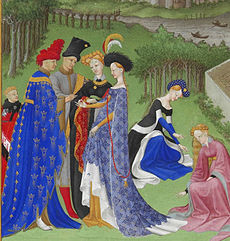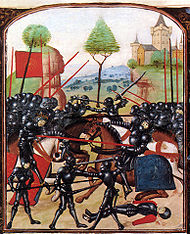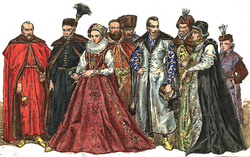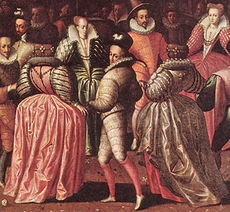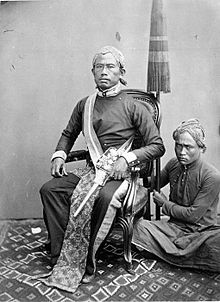- Nobility
-
For other uses, see Noble (disambiguation).
Nobility is a social class which possesses more acknowledged privileges or eminence than members of most other classes in a society, membership therein typically being hereditary. The privileges associated with nobility may constitute substantial advantages over or relative to non-nobles, or may be largely honorary (e.g. precedence), and vary from country to country and era to era. Traditionally membership in the nobility has been regulated or acknowledged by the government. There is often a variety of ranks within the noble class. Legal recognition of nobility is more common in monarchies, but nobility also existed in such republics as the Dutch Provinces, Genoa and Venice, and remains part of the legal social structure of some non-hereditary regimes, e.g. San Marino and Vatican City in Europe. Hereditary titles often distinguish nobles from non-nobles, although in many nations most of the nobility have been un-titled, and a hereditary title need not indicate nobility.
Contents
History
 Nobility offered protection in exchange for service
Nobility offered protection in exchange for service
The term derives from Latin nobilis (well-known, famous), indicating those who were "well-known" or "notable" in society, and was applied to the highest social class in pre-modern societies. In the feudal system (in Europe and elsewhere), the nobility were generally those who held a fief, often land or office, under vassalage, i.e., in exchange for allegiance and various, mainly military, services to a suzerain, who might be a monarch or a higher-ranking nobleman. It rapidly came to be seen as a hereditary caste, sometimes associated with a right to bear a hereditary title and, for example in pre-revolutionary France, enjoying fiscal and other privileges.
While noble status formerly conferred significant privileges in most jurisdictions, by the 21st century it had become a largely honorary dignity in most societies, although a few, residual privileges may still be preserved legally (e.g. Netherlands, Spain, UK) and some Asian, Pacific and African cultures continue to attach considerable significance to formal, hereditary rank or titles. (Compare the entrenched position and leadership expectations of the nobility of the Kingdom of Tonga.)
Nobility is a historical, social and often legal notion, differing from socio-economic status (or class) in that the latter is mainly based on income, possessions and/or lifestyle. Being wealthy or influential cannot, ipso facto, make one noble, nor are all nobles wealthy or influential (aristocratic families have lost their fortunes in various ways, and the concept of the 'poor nobleman' is almost as old as nobility itself).
Although many societies have a privileged 'upper class' with substantial wealth and power, the status is not necessarily hereditary and does not entail a distinct legal status, nor differentiated forms of address. Nobles are also high on the chain. They are just below the kings and above the knights and peasants.
Various republics, including the United States, former Iron Curtain countries, Greece, Mexico, and Austria have expressly abolished the granting and/or use of titles of nobility to or by their citizens. This is distinct from countries which have not abolished the right to inherit (formerly) noble titles, but which do not grant legal recognition or protection to them, such as Germany, and Italy, although Germany recognizes their use as legal surnames. Still other countries and authorities allow their use, but forbid attachment of any privilege thereto, e.g. Finland, France, Norway and the European Union, although French law also protects lawful titles against usurpation, while Norway allows the use of traditional titles by official members of the royal house.
Noble privileges
Nobles did not always derive their privileges from just being nobles, but usually privileges were granted with a specific title, office or estate. However, nobles were often treated better. Nobles often derived wealth from one or more estates, large or small, that might include fields, pasture, orchards, timberland, hunting grounds, streams, etc. It also included infrastructure such as castle, well and mill to which local peasants were allowed some access.
Prior to the French Revolution, European nobles typically commanded tribute in the form of entitlement to cash rents or usage taxes, labour and/or a portion of the annual crop yield from commoners or nobles of lower rank who lived or worked on the noble's manor or within his seigneurial domain. In some countries, the local lord could impose restrictions on such a commoner's movements, religion or legal undertakings. The nobles enjoyed the privilege of hunting. In France, nobles were exempt from paying the taille, the major direct tax. The peasants were not only bound to the nobility by dues and services. The nobility also had the jurisdictions of the courts and the police over them. In many parts of western Europe the right of private war long remained the privilege of every noble.[1]
During the early Renaissance, duelling established the status of a respectable gentleman, and was an accepted manner to resolve disputes.[2] According to Ariel Roth, during the reign of Henry IV, over 4,000 French aristocrats were killed in duels "in an eighteen-year period" whilst a twenty-year period of Louis XIII's reign saw some eight thousand pardons for "murders associated with duels".[3]
Ennoblement
In France, a seigneury might include one or more manors surrounded by land and villages subject to the noble's prerogatives and disposition. Seigneuries could be bought, sold or mortgaged. But if erected into, e.g. a barony or countship, was legally entailed for a family, who could use it as their title (although most nobles were untitled: "seigneur of Montagne" meant ownership of the lordship but not, if one was not otherwise noble, the right to use its associated title). However, any French noble who bought a countship was allowed, ipso facto, to style himself as its comte.
By contrast, in the UK royal letters patent were necessary to take a noble title, which also carried a seat in the House of Lords, but came with no automatic entail nor rights to the local peasants' output.
Quite often, however, nobility came to be associated only with specific social privileges and a general expectation of deference from those of lower rank. An example of the latter would be early 20th-century Polish nobility after their political, economic, judicial and religious privileges were abolished in 1923 and they remained only landed proprietors on the same legal basis as their landed-commoner neighbours
European nobility
European nobility originated in the feudal/seignorial system that arose in Europe during the Middle Ages.[4] Originally, knights or nobles were mounted warriors who swore allegiance to their sovereign and promised to fight for him in exchange for an allocation of land (usually together with serfs living thereon). During the period known as the Military Revolution, nobles gradually lost their role in raising and commanding private armies, as many nations created cohesive national armies.
This was coupled with a loss of the socio-economic power of the nobility, owing to the economic changes of the Renaissance and the growing economic importance of the merchant classes (or bourgeoisie), which increased still further during the Industrial Revolution. In countries where the nobility was the dominant class, the bourgeoisie gradually grew in power; a rich city merchant came to be more influential than a nobleman, and the latter sometimes sought inter-marriage with families of the former to maintain their noble lifestyles.
However, in many countries at this time, the nobility retained substantial political importance and social influence: for instance, the UK's government was dominated by the nobility until the middle of the 19th century. Thereafter the powers of the nobility were progressively reduced by legislation (see Reform of the House of Lords).
The countries with the highest proportion of nobles were probably Castile, Poland and Lithuania, each with about 10% of the total population, as compared to 0.5-2% elsewhere in Europe. In Hungary, yet another frontier region, nobles made up 5% of the population. On the frontiers of Europe, western and eastern alike, ongoing warfare against ethnic outsiders – Turks and Tatars in eastern Europe, Moors (until 1492) in Spain – gave large numbers of new men access to higher status; and the booty of conquest provided the material bases for their advancement.[5]
Rank within the nobility
The nobility of a person might be either inherited or conferred by a fons honorum. Nobility in its most general and strict sense is an acknowledged preeminence that is hereditary, i.e. all legitimate, male-line descendants of noblemen are noble. In this respect, nobility has long been distinguished from noble titles, such as peerages in France and the UK, grandezas in Portugal and Spain, and some noble titles in Belgium, Denmark, Italy, the Netherlands, Prussia and Sweden. In the Netherlands and Spain, noble titles are now equally heritable by females and males.
Aristocrat and aristocracy, in modern usage, refer informally and broadly to persons belonging to a noble's family or social milieu. Those lacking a distinct title, such as junior siblings of peers, wealthy members of the landed gentry (and perhaps even the children of 'self-made' VIPs) may be considered aristocrats, moving within a small social circle at the apex of a hierarchical social pyramid.[citation needed]
In France, some wealthy bourgeois, most particularly the members of the various parlements, were ennobled by the king, constituting the noblesse de robe. The old nobility of landed or knightly origin, noblesse d'épée, increasingly resented the pretensions and influence of this parvenu nobility. In the last years of the ancien régime the old nobility pushed for restrictions of certain offices and orders of chivalry to noblemen who could demonstrate that their lineage had sufficient "quarterings", i.e. noble ancestry (matrilineal as well as patrilineal), to deserve to compete as equals with nobles of medieval descent for offices and favors at court, (although historians such as William Doyle have disputed this so-called "Aristocratic Reaction". (W. Doyle, Essays on Eighteenth Century France, London, 1995)). Various court and military positions were reserved by tradition for nobles who could "prove" an ancestry of at least seize quartiers (sixteen quarterings), indicating exclusively noble descent (as displayed, ideally, in the family's coat of arms) extending back five generations (all sixteen great-great grandparents).
This illustrates the traditional link in many countries between heraldry and nobility; in those countries where heraldry is used, nobles have almost always been armigerous, and have used heraldry to demonstrate their ancestry and family history. However, it is important to note that heraldry has never been restricted to the noble classes in most countries, and being armigerous does not necessarily demonstrate nobility.
An opinion of Innes of Learney makes an observation of the system in use in Scotland, differentiating it from many other European traditions, in that legal armorial bearings which are entered in the Public Register of All Arms and Bearings in Scotland by warrant of the Lord Lyon King of Arms are by statute "Ensigns of Nobility". However, this opinion is challenged by a scholar.[6] Innes of Learney's perspective is, however, accepted in the Stair Memorial Encyclopaedia.[7] In a number of recent cases in Scotland the Lord Lyon Kings of Arms has controversially granted the arms and allowed the chiefships of medieval noble families to female line descendants of lords, even when they are not of noble lineage in the male line and legitimate claimants (agnates) still exist, for example in the extraordinary case of the modern Chiefs of Clan MacLeod. This is strictly against Gaelic law and thus the true chiefships technically become defunct, even if they continue to be recognized by the Scottish government for commercial purposes (tourism, etc.). Scotland's Gaelic nobility have been disintegrating as a result for the last few decades.
In the modern age, inherited nobility with special rights has largely been abolished in the Western World as intrinsically discriminatory and discredited as inferior in efficiency to individual meritocracy in the allocation of societal resources.
Many nations traditionally had an untitled lower nobility (including, in continental Europe, hereditary knights) in addition to titled nobles. Examples are the landed gentry of the British Isles, the Junkers of Germany, the noblesse de robe of France, the hidalgos of Spain and the nobili of Italy.
Some con artists sell fake titles of nobility, often with impressive-looking documents to back them up. These may be illegal, depending on local law. They are more often illegal in countries that actually have nobilities, such as European monarchies. In the U.S., such commerce may constitute actionable fraud rather than criminal usurpation of an exclusive right to use of any given title by an established class.
"Blue" blood
Blue blood is an English idiom recorded since 1834 for noble birth or descent; it is a translation of the Spanish phrase sangre azul, which described the Spanish royal family and other high nobility who claimed to be of Visigothic descent,[8] in contrast to the Moors. It is likely that the idiom originates from ancient and medieval societies of Europe and distinguishes an upper class (whose superficial veins appeared blue through their untanned skin) from a working class of the time. The latter consisted mainly of agricultural peasants who spent most of their time working outdoors and thus had tanned skin, through which superficial veins appear less prominently.
Robert Lacey explains the genesis of the blue blood concept:
It was the Spaniards who gave the world the notion that an aristocrat's blood is not red but blue. The Spanish nobility started taking shape around the ninth century in classic military fashion, occupying land as warriors on horseback. They were to continue the process for more than five hundred years, clawing back sections of the peninsula from its Moorish occupiers, and a nobleman demonstrated his pedigree by holding up his sword arm to display the filigree of blue-blooded veins beneath his pale skin—proof that his birth had not been contaminated by the dark-skinned enemy.[9]
However, there has been offered another explanation for the genesis of the blue blood concept. That is the extraordinarily high incidence of hemophilia among royal families. Not only has hemophilia been called "the Royal Disease",[10] but its origins in the family tree of Queen Victoria apparently spread throughout Europe's monarchies, such that those with the disease were overly protected, did not go out of doors much and their skin appeared bluish. As referenced above, the Spanish nobility of the time were thought to carry the hemophilia line, as Victoria's grand daughter Eugenie married King Alfonso XIII of Spain, which may contradict (or complement) the Lacey explanation.
Asian nobility
Medieval Japan developed a feudal system similar to the European system, where land was held in exchange for military service. The daimyo class, or hereditary landowning nobles, had great social and political power. Like their European counterparts, they commanded private armies made up of samurai, an elite warrior class; for long periods, these held real power without a real central government and often plunged the country into a state of civil war. Although there are differences, the daimyo class can be compared to European peers, and the samurai to European knights, but with important differences, such as the distinction between the European code of chivalry and the Japanese code of bushido. These feudal titles and ranks were abolished in Japan with the Meiji Restoration of 1868 and replaced by the kazoku, a five-rank peerage system after the British example which granted seats in the upper house of the Imperial Diet, but this too was abolished in 1947, following Japan's defeat in World War II.
Many other non-European nations have had noble or aristocratic classes of various kinds: these are so diverse that it is somewhat misleading to try to translate them all into western feudal terminology. For the feudal hierarchy on the Indian subcontinent, see princely state.
In some Islamic countries, there are no definite nobility titles (titles of hereditary rulers being distinct from those of hereditary intermediaries between monarchs and commoners). Persons who can trace legitimate descent from the Prophet (as can several present or formerly reigning dynasties, and their relatives) are widely regarded as belonging to the ancient, hereditary Islamic nobility. In some Islamic countries they inherit (through mother or father) hereditary titles, although without any other associated privilege, e.g., variations of the title Sayyid. Commonly regarded as more religious than the general population, many people turn to them for clarification or guidance in religious matters.
In Iran, historical titles of the nobility include Mirza, Khan, ed-Dowleh, Shahzada, now no longer recognized. An aristocratic family is now recognized by family name (often derived from the post held by their ancestors, considering the fact that family names in Iran only appeared in the beginning of the 20th century).
In East Asia the system was often modelled on imperial China, the leading culture. There the emperors conferred degrees of nobility, which were not permanent but decreased a rank each generation. Descendants of the emperors formed the highest class of ancient Chinese nobility, status of the descendants being based upon the rank of the empress or concubine from which they descend maternally (as emperors were polygamous). Numerous titles such as Taizi, and equivalents of "prince/princess" were accorded. Due to complexities in dynastic rules, rules were introduced for Imperial descendants.
China had a feudal system in the Shang and Zhou dynasties, but it gradually gave way to a more bureaucratic system beginning in the Qin dynasty (221 BC). This continued through the Song Dynasty. By its peak, only the Immediate family members of the Emperor were considered to be nobles.
The development however, was gradual and generally only completed in full by the Song Dynasty, in the Han Dynasty for example, even though noble titles were no longer given to those outside of the Emperor's relatives, the fact that the process of selecting officials was mostly based on a vouching system by current officials, it caused a quasi form of nobility as typically officials will jus vouch for the sons of their own sons or the sons of other officials. This process was further deepened during the Three Kingdoms Period with the introduction of the Nine-rank system.
Costume of a family belonging to Principalía during the 19th century. Picture taken from the exhibit in Villa Escudero Museum in San Pablo Laguna, Philippines.
However, by the Sui Dynasty the founding of the Imperial examination system marked the beginning of a full transformation towards full bureaucracy, though the process wouldn't be truly complete until the Song Dynasty
Dynasties established by the minority non-Han rulers via conquest in later years disrupted this ancient system of social class within Han society. They compelled conformity to an ethnic policy wherein the Mongols and the Manchus were accorded higher social status than the Han majority whom they dominated.
By the time of the Qing dynasty, many titles had been obtained or degraded through abuse and perversion of the original Qin system. Titles of nobility were still granted by the emperor, but served merely as honorifics based on a loose system of favors to the Qing emperor and Manchu interests: under a centralized system, governance in the empire was the responsibility of the Confucian-educated scholar-officials and local gentry. The literati were accorded gentry status based on lineage. For male citizens, advancement in status was possible via success in the top three positions in imperial examinations.
The bestowal of titles was abolished with the establishment of the People's Republic of China in 1949, as part of a larger effort to abolish feudal influences on Chinese society.
In tribal societies, such as the Polynesian Island states, the system of often (semi-)hereditary tribal chiefs can also be compared to a form of noble class. In Tonga, after contact with Western nations, the traditional system of chiefs developed into a Western-style monarchy with a hereditary class of "barons", even adopting that English title.
In the Philippines and other southeast Asian countries, there have been the local nobilities. The Datu is the title for tribal chief and monarchs; in some parts of the Philippines the other term for the title is Apo.[11] Together with Sultan and Rajah, they are also titles used for native royalty and are currently used in the Philippines, Indonesia, Malaysia and Brunei. These titles are the equivalent of European dukes and marquesses. The word datu was derived from the Malay word: Dato' or Datuk, which are royal titles of the Ethnic Malays.
Upon the Christianization of the Philippines, the datus (king) of the pre-Hispanic kingdoms retained their right to govern their territory under the Spanish Empire. King Philip II of Spain, in a law signed June 11, 1594,[12] commanded that these nobles be given the same respect, and privileges that they had before their conversion. These nobles formed part of the exclusive, and elite ruling class, called the Principalía (Nobility), in municipalities of the Spanish Philippines.
Nobility by nation
A list of noble titles for different European countries can be found at Royal and noble ranks. To learn how to properly address holders of these titles, see Royal and noble styles.
- For the English Wikipedia category, see Category:Nobility by nation
 Italian Nobleman of the Fifteenth Century. Engraving from the so-called Mantegna Tarocchi, about 1465.
Italian Nobleman of the Fifteenth Century. Engraving from the so-called Mantegna Tarocchi, about 1465.
- Armenian nobility
- Austrian nobility
- Baltic nobility related to the modern area of Estonia and Latvia
- Belgian nobility
- Bohemian nobility
- Brazilian nobility
- British nobility
- Chinese nobility
- Croatian nobility
- Cuban nobility
- Danish nobility
- Dutch nobility
- Fijian nobility
- Finnish nobility
- French nobility
- German nobility
- Hungarian nobility
- Imperial Roman titles
- Irish nobility
- Italian nobility
- Japanese nobility
- Korean nobility
- Lithuanian nobility
- Malay nobility
- Malagasy nobility
- Mexican nobility
- Mongolian nobility
- Nigerian nobility
- Norwegian nobility
- Ottoman titles
- Polish nobility
- Polynesian nobility
- Principalía (Philippines)
- Romanian nobility
- Russian nobility
- Samoan nobility
- Serbian nobility
- Spanish nobility
- Swedish nobility
- Switzerland nobility
- Thai royal and noble titles
See also
- Almanach de Gotha
- Aristocracy (class)
- Caste (social hierarchy of India)
- Ennoblement
- False titles of nobility
- Gentleman
- Gentry
- Heraldry
- King
- The Military Revolution
- Nobiliary particle
- Patrician (ancient Rome)
- Patrician (post-Roman Europe)
- Peerage
- Redorer son blason
- Royal and noble ranks
- Social environment
- Symbolic capital
- Honour
- Ascribed status
- Military elite
References
- ^ "Nobility". 1911 Edition of the Encyclopaedia Britannica.
- ^ Jonathan, Dewald (1996). The European nobility, 1400-1800. Cambridge University Press. p. 117. ISBN 052142528X. http://books.google.com/books?id=-fct5tlRFwEC&pg=PA117&dq#v=onepage&q=&f=false.
- ^ The Dishonor of Dueling, Ariel A. Roth
- ^ Nobility and Analogous Traditional Elites, p. 94 TFP.org
- ^ Jonathan, Dewald (1996). The European nobility, 1400-1800. Cambridge University Press. pp. 22–25. ISBN 052142528X. http://books.google.com/books?id=-fct5tlRFwEC&pg=PA25&dq#v=onepage&q=&f=false.
- ^ The Lord Lyon and his Jurisdiction
- ^ Stair Memorial Encyclopaedia, 'Heraldry' (Volume 11), 3, The Law of Arms. 1613. The nature of arms.
- ^ The politics of aristocratic empires by John Kautsky
- ^ Robert Lacey, Aristocrats. Little, Brown and Company, 1983, p. 67
- ^ Hemophilia: The Royal Disease, by Yelena Aronova-Tiuntseva and Clyde Freeman Herreid, University at Buffalo, State University of New York
- ^ The Olongapo Story, July 28, 1953 - Bamboo Breeze - Vol.6, No.3
- ^ “It is not right that the Indian chiefs of Filipinas be in a worse condition after conversion; rather they should have such treatment that would gain their affection and keep them loyal, so that with the spiritual blessings that God has communicated to them by calling them to His true knowledge, the temporal blessings may be added and they may live contentedly and comfortably. Therefore, we order the governors of those islands to show them good treatment and entrust them, in our name, with the government of the Indians, of whom they were formerly lords. In all else the governors shall see that the chiefs are benefited justly, and the Indians shall pay them something as a recognition, as they did during the period of their paganism, provided it be without prejudice to the tributes that are to be paid us, or prejudicial to that which pertains to their encomenderos.” Felipe II, Ley de Junio 11, 1594 in Recapilación de leyes, lib. vi, tit. VII, ley xvi. Also cf. Emma Helen Blair and James Alexander Robertson, The Philippine Islands (1493-1898), Cleveland: The A.H. Clark Company, 1903, Vol. XVI, pp. 155-156.
External links
- The German nobility
- WW-Person, an on-line database of European noble genealogy
- Paul Theroff's An Online Gotha
- Genealogics, an extensive database of European nobles
- Worldroots, a selection of art and genealogy of European nobility
- RoyalArk- ruling houses in many non-European countries
- The Russian Nobility Association in America
- Italian dynastic genealogies (in Italian, with an introduction in English)
- Worldwidewords
- A Glossary of Titles in 35 Languages
- Etymology OnLine
- Friesian- Feudal Hierarchy (scroll down)
- Heraldica.org - European Noble, Princely, Royal and Imperial Titles
- Genesis of European Nobility
Social stratification: Social class Baronets • Bourgeoisie • Chattering classes • Classlessness • Creative class • Gentry • Lower middle class • Lumpenproletariat • Middle class • New class • Nobility • Nouveau riche/Parvenu • Old Money • Peasant/Serf • Petite bourgeoisie • Proletariat • Redneck • Ruling class • Slave class • Subaltern • Underclass • Upper class • Upper middle class • White trash • Working class • Working poorBy collar
Wikimedia Foundation. 2010.

